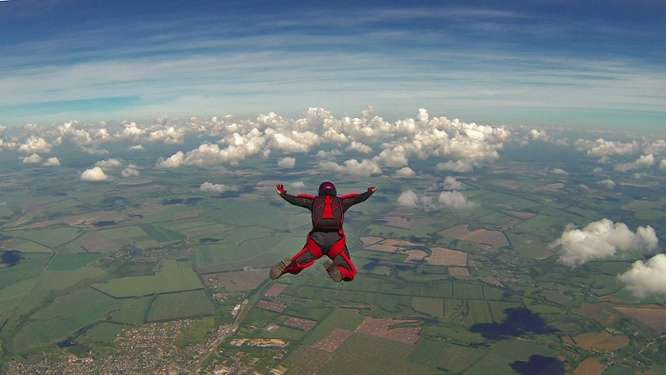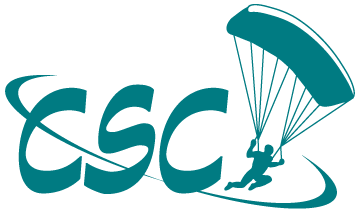You’ve got a few tandem freefalls under your belt, and needless to say — you’re hooked!
But while skydiving with a jumpmaster is great and all, you think you’re ready to go solo.
You know this will require some schooling and training, but how hard is it to get a skydiving license, really?
The good news is, it’s not that difficult for those with a true passion for freefalling. It does, however, require a few months of time and dedication. Here’s how you’d get started:

Starting with Your “A” Skydiving License
Unlike getting your driver’s license, skydiving licenses are not a once-and-done deal. The United States Parachute Association (USPA) regulates four tiers of skydiving licensing from “A” to “D.”
Like you may have guessed, the first tier for new solo skydivers is “A” and the most advanced tier for skydivers is a “D” license.
To start pursuing your A License, you can go to any USPA-affiliated dropzone to start your training.
Step 1: Ground Training
When learning about any new subject, you typically start in the classroom before moving to the actual application. The same is true for skydiving.
Your skydiving instruction starts on the ground, getting to know your skydiving equipment and safety protocols. You may already know a thing or two about this from jumping with a tandem instructor, but now you’ll learn through the eyes of a solo freefaller, learning the true ins-and-outs of skydiving for yourself instead of watching a jumpmaster do it.
Here at Chicagoland Skydiving Center, this on-the-ground training is a part of our “First Jump Course” in our Freefall University. We also offer free ground school courses once a month to give you a taste of what’s to come before committing to the full course.
You’ll also be expected to do some readings and take a few exams to prove you’ve retained what you’ve learned.
Step 2: Tandem Jumps
After learning about your parachute, equipment and maneuvers, you’ll take to the sky. Just like when you first tried skydiving, you’ll be freefalling with a tandem instructor.
You must complete two training tandems before your first “solo” jump. With your instructor strapped to you, you’ll have more direct attention learning the freefall maneuvers, monitoring altitude, deploying the parachute and assisting the instructor on the landing.
Step 3: Technical Jumps
After jumping twice with a certified tandem instructor attached, you’ll be ready for more technical skills, including:
Accelerated Freefall (AFF) Jumps
AFF stands for Accelerated Freefall, which is the name of this particular training method.
This time, you’ll be wearing your own chute— as the one calling the shots— with an instructor holding onto your arm and side as you fall. The jumpmaster will counsel you on maneuvers and emergency procedures, as needed. You’ll also receive assistance via radio mid-air.
You’ll need to perform seven “levels” of these jumps to proceed with your A License, each a little more challenging than the last. Watch video walkthroughs of all seven AFF jumps by skipping the “Solo Skydiving Classes” section of our Solo Skydive Requirements article.
Coach Jumps
After your AFF jumps are completed, you’ll move onto what we call coach jumps. Here your Coach will let you have more independence in the air, all while teaching you more advanced maneuvers. At our FreeFall U, you can expect six of these skydive lessons before moving onto the next stage.
Hop n Pop Jumps
The prior jumps operated on the assumption that everything goes as planned when freefalling. In order to get your A License, you’ll also need to be prepared for the unexpected.
Hop N Pops simulate what you must know in the event of an aircraft emergency. During these two required lessons, you’ll be taught how to exit the plane and deploy a parachute with minimal freefall.
Student Solo Jumps
After over a dozen jumps on your track record, you’ll start jumping on your own. While the instructor will prepare and run these jumps, you won’t receive assistance during freefall unless absolutely necessary.
The whole idea of these remaining jumps is to grow your independence in the air. You’ll perform these solo skydives until you reach 25 total jumps during training.
Additional Training
In the event that you can’t get a jump scheduled or there’s too much time between your required jumps, you may have to opt for some additional training to stay in good standing with the USPA.
While this may sound like a “penalty” of some kind for missing licensure requirements, all additional training is offered to help prospective licensees pick up where they left off.
Does additional training still cost money? Yes.
It also saves you from having to restart the licensing process from square one.
So if you find yourself in a unique position where you’re not able to finish your licensing in a set amount of time, additional training options might be perfect for you.
Unlicensed Recurrency Training
One of the terms of FreeFall U is that you must jump at least once every 30 days after you start your program to stay sharp. Should you miss a jump, you’ll need to enroll in recurrency training at an additional cost to catch up.
This rule is put in place to ensure you are consistently learning and retaining your lessons while pursuing your skydiving A License.
Tunnel Training
Some students choose to learn skydiving in a simulated indoor tunnel experience prior to beginning formal skydiving license training. Not only does it remove some of the pressure for newbies, but practicing indoors can save Freefall U students as much as $300 off their license.
Plus, it’s pretty cool to freefall in a clear glass room with your instructor standing next to you!
Ready to Enroll?
Are you itching to get started pursuing your dream? Start your License A training with one of Chicago’s top-rated skydiving centers.
Sign up for Freefall U today!


